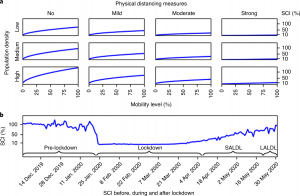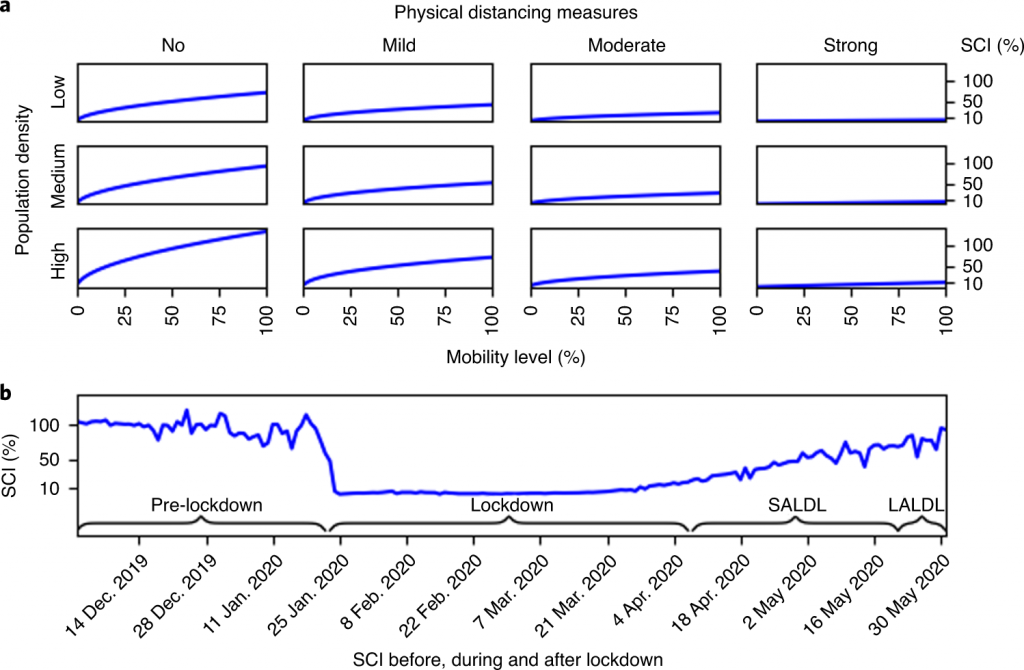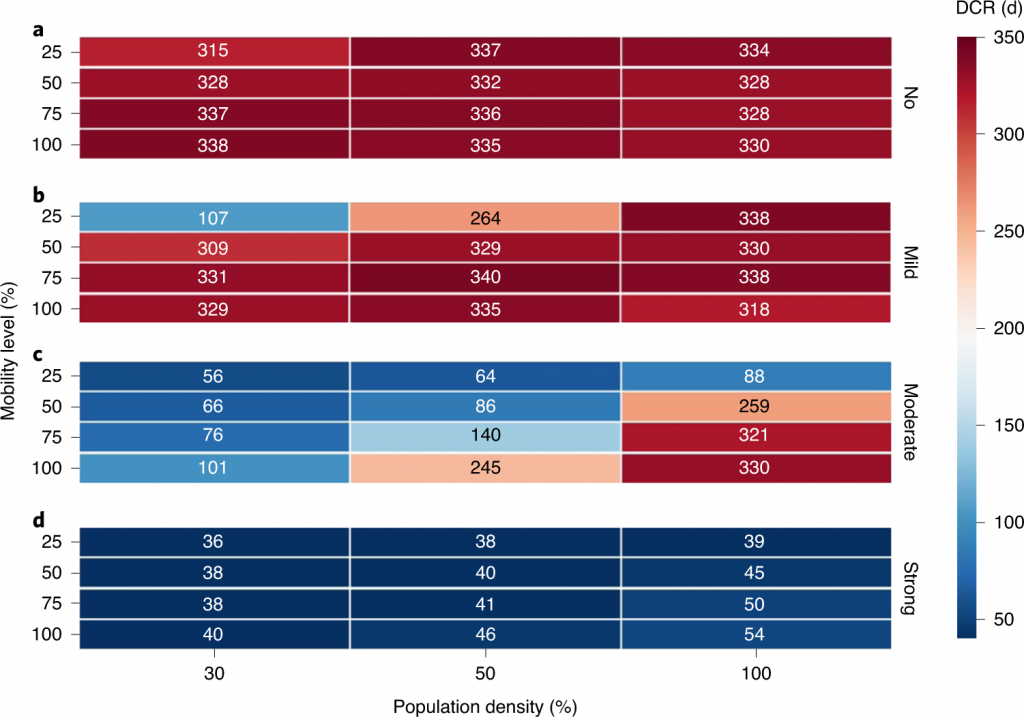News Centre
CUHK Study Shows Combined Vaccination and Physical Distancing Measures Critical for Preventing COVID-19 Resurgence
COVID-19 vaccination programmes have started to roll out across the globe for the prevention and control of the pandemic. The Chinese University of Hong Kong (CUHK) has conducted an epidemiological study investigating the effect of vaccination on preventing COVID-19 resurgence. The results show that by administering effective vaccines, the physical distancing measures can be relaxed to varying degrees until herd immunity is achieved (the vaccination rate reaches about 64% in one year), for cities with low, medium or high population density. The study has been published in Nature Human Behaviour.
Since the summer of 2020, after many countries relaxed lockdown and physical distancing measures in the course of reopening, COVID-19 cases have resurged worldwide, especially in winter. Maintaining physical distancing including closure of schools, shops and workplaces is critical to slow the spread of infections in the absence of effective vaccines. However, such interventions have caused significant disruptions to societies and economies and people are fatigued from them.
Vaccines are deemed essential to alleviate physical distancing and other non-pharmaceutical interventions and eventually halt the transmission of COVID-19. However, the extent of potential alleviation is still unclear, especially given that the supply of vaccines will likely not be sufficient to achieve herd immunity in the immediate future. Therefore, a multi-disciplinary team of researchers from CUHK including Professor Bo Huang, Department of Geography and Resource Management, Professor Paul Chan, Department of Microbiology, Professor Tony Tam, Department of Sociology and Professor Yingyi Hong, Department of Management has studied the joint effects of vaccination and physical distancing in avoiding resurgences and generalised their approaches to it for other cities with varying population densities, in collaboration with the WorldPop project of the University of Southampton.
A challenge in this study was that several aspects were involved, including reopening, stay-at-home orders, physical distancing such as closure of non-essential facilities, vaccination, and population density. Using anonymised mobile geolocation data in mainland China, the team devised a mobility-associated social contact index (SCI) referencing the mobility data of Wuhan between pre-lockdown and post-lockdown periods from January to April 2020, to quantify the impact of both physical distancing and vaccination measures in a unified way such that the gaps between intervention measures and disease transmission can be bridged.
Specifically, the effect of the multiple aspects, which are mobility restoration (representing reopening), physical distancing, mobility reduction, and vaccination, on increasing or reducing susceptible social contacts can be accounted for and quantified using the proposed SCI model. For instance, assuming that the effectiveness of the inoculated vaccine is 75%, this indicates the vaccinated population may have a probability of 75% to undertake their daily routine without worrying about being infected or infecting others. This ratio is equivalent to the reduced susceptible social contacts brought about by 75% of the population following strict physical distancing or staying at home (Figure 1).

Figure 1. Change in the SCI in Wuhan with different levels of population density and physical distancing. a, Each chart shows changes in the SCI (as a percentage of the average pre-lockdown SCI) over mobility levels from 0% (no population movement) to 25%, 50% and 100% (no stay-at-home order) under different population densities (low, medium or high) and no, mild, moderate or strong physical distancing measures. The charts correspond to varying intensities of physical distancing imposed during pre-lockdown (no), LALDL (mild), SALDL (moderate) and lockdown (strong) in Wuhan. b, The daily change of the SCI (as a percentage of the average pre-lockdown SCI) in Wuhan between December 2019 and May 2020.
Linking the resulting contact rates with a susceptible-exposure-infectious-recovered (SEIR) model, several combinatorial interventions were assessed, with consideration to the efficacy of vaccines, immunity fading rates of the recovered and vaccinated population and intensities of physical distancing.
On the assumptions that the vaccination process would reach approximately 64% of the population in one year to achive herd immunity and that the effectiveness of vaccines was set as 75%, for cities with medium population density (approximately 50% of the population density in Wuhan), vaccination can shorten the duration of physical distancing by 36% – 78% (Figure 2), whereas for cities with high population density (similar to Wuhan), vaccination can lower the minimally required intensity of physical distancing measures and show greater efficacy in reducing the number of new infections (Table 1). Compared with the no-vaccination scenario, vaccination combined with physical distancing can contain resurgences without relying on mobility reduction, whereas a gradual vaccination process alone cannot achieve this. The team strongly recommends commencing a vaccination process as soon as possible for cities with high population density because these cities need to pay more in costs to stem potential resurgences. Meanwhile, physical distancing measures should be maintained until herd immunity is achieved.

Figure 2. Estimated effects of control measures on containing a resurgence of infections under different population densities. (a)-(d) show, for four intensities of physical distancing (no, mild, moderate, and strong), respectively, the median duration required to contain a resurgence (DCR, unit: days) in Wuhan with four levels of pre-lockdown mobility (25%, 50%, 75%, and 100%) under different population densities. The value in each cell denotes the DCR with respect to its associated level of mobility, intensity of physical distancing, and population density. The population densities are 30%, 50%, and 100%, respectively, of that in Wuhan pre-lockdown.
Table 1: Validation results of joint vaccination and physical distancing measures in high-density cities
|
Physical distancing |
Infected cases in one year (95% CI) |
Reduction rate of casesᵃ |
Duration under physical distancing |
City |
Population density (people/km2) |
|
No |
10.23% (9.21%-10.85%) ᵇ |
– |
– |
Chengdu |
1123 |
|
Mild |
2.15% (1.25%-2.92%) ᵇ |
78.95% |
350 (335-355) |
||
|
Moderate |
5353 (3285-8368) |
99.95% |
278 (240-310) |
||
|
Strong |
251 (152-417) |
99.99% |
53 (39-81) |
||
|
No |
10.23% (8.14%-11.11%)ᵇ |
– |
– |
Beijing |
1312 |
|
Mild |
3.11% (1.55%-3.93%)ᵇ |
69.63% |
347 (326-354) |
||
|
Moderate |
4297 (2062-6437) |
99.96% |
261 (215-302) |
||
|
Strong |
209 (116-310) |
99.99% |
40 (30-57) |
||
|
No |
17.72% (16.26%-18.74%)ᵇ |
– |
– |
Wuhan’s high-density scenario |
1128 |
|
Mild |
0.40% (0.22%-0.60%)ᵇ |
97.72% |
350 (338-354) |
||
|
Moderate |
1800 (991-2821) |
99.99% |
234 (166-295) |
||
|
Strong |
213 (122-347) |
99.99% |
43 (33-64) |
ᵃ The reduction rate of cases refers to the percentage of cases that could be reduced if relevant physical distancing intensity were applied compared with a no physical distancing scenario. The no physical distancing scenario is marked as “-.”
ᵇ The number of cases is presented in the form of a percentage of potentially exposed population (approximately 107.83, 112.79, and 102.25 million in Chengdu, Beijing, and Wuhan, respectively, including travellers) because of the large numbers.
Reference: https://www.nature.com/articles/s41562-021-01063-2

Figure 1. Change in the SCI in Wuhan with different levels of population density and physical distancing. a, Each chart shows changes in the SCI (as a percentage of the average pre-lockdown SCI) over mobility levels from 0% (no population movement) to 25%, 50% and 100% (no stay-at-home order) under different population densities (low, medium or high) and no, mild, moderate or strong physical distancing measures. The charts correspond to varying intensities of physical distancing imposed during pre-lockdown (no), LALDL (mild), SALDL (moderate) and lockdown (strong) in Wuhan. b, The daily change of the SCI (as a percentage of the average pre-lockdown SCI) in Wuhan between December 2019 and May 2020.

Figure 2. Estimated effects of control measures on containing a resurgence of infections under different population densities. (a)-(d) show, for four intensities of physical distancing (no, mild, moderate, and strong), respectively, the median duration required to contain a resurgence (DCR, unit: days) in Wuhan with four levels of pre-lockdown mobility (25%, 50%, 75%, and 100%) under different population densities. The value in each cell denotes the DCR with respect to its associated level of mobility, intensity of physical distancing, and population density. The population densities are 30%, 50%, and 100%, respectively, of that in Wuhan pre-lockdown.

